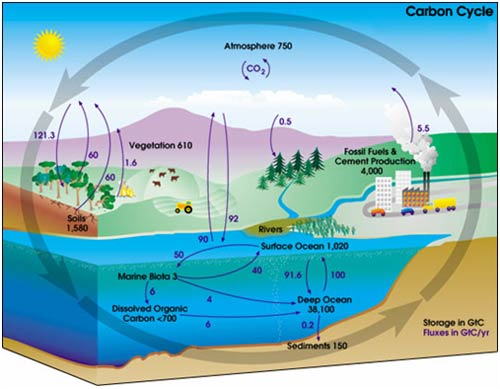
Many people correctly note that human CO2 emissions are only about 4% of natural CO2 emissions. The incorrect conclusion, however, is that because our emissions are a fraction of total emissions, they cannot be causing the current warming. This argument confuses the concepts of emissions vs. accumulation. With regard to the warming effect of GHG’s, it is only the accumulation in the atmosphere that matters, not their emissions. To understand the difference between emissions and accumulation, let’s consider the finances of our fictional friend, Bob.

Bob has an annual income of $50,000. How long will it take him to accumulate $10,000?
Bob’s annual expenses (including taxes) are $50,000. Therefore, Bob will never accumulate $10,000, because his income is balanced by his expenses. In technical jargon we say that his income is in equilibrium with his expenses. In the common vernacular we say that he is living hand to mouth.
But then Bob’s finances change.
Although $2000 is just 4% of $50,000, a fraction of his base income, because $2000/yr is above and beyond Bob’s regular expenses, it accumulates in his savings account, even after paying the 50% inheritance tax. In this manner the relatively small inheritance becomes a big deal in Bob’s finances.
Up to the Industrial Revolution (i.e., up until about 1820), natural CO2 sources were in equilibrium with natural CO2 sinks, so that CO2 did not accumulate in the atmosphere. As of 2020, human CO2 emissions are about 4% higher than natural CO2 sources. About half of the human CO2 emissions are absorbed by the biosphere (i.e., land and oceans), but that leaves the other half to accumulate in the atmosphere.
Therefore, even though human emissions are a fraction of natural emissions, human emissions are a big deal because our emissions put the overall system out of balance. Nature was in a delicate balance before the Industrial Revolution, not accumulating CO2 in the atmosphere, but now our emissions have put the system out of balance. The accumulation of CO2 in the atmosphere of about 2.5 ppm/year is due to human emissions.
Gavin Cawley is a Senior Lecturer in Computing Sciences at the University of East Anglia. He has two very instructive videos on the carbon cycle here and here.
Posted by Evan on Friday, 29 October, 2021
 |
The Skeptical Science website by Skeptical Science is licensed under a Creative Commons Attribution 3.0 Unported License. |